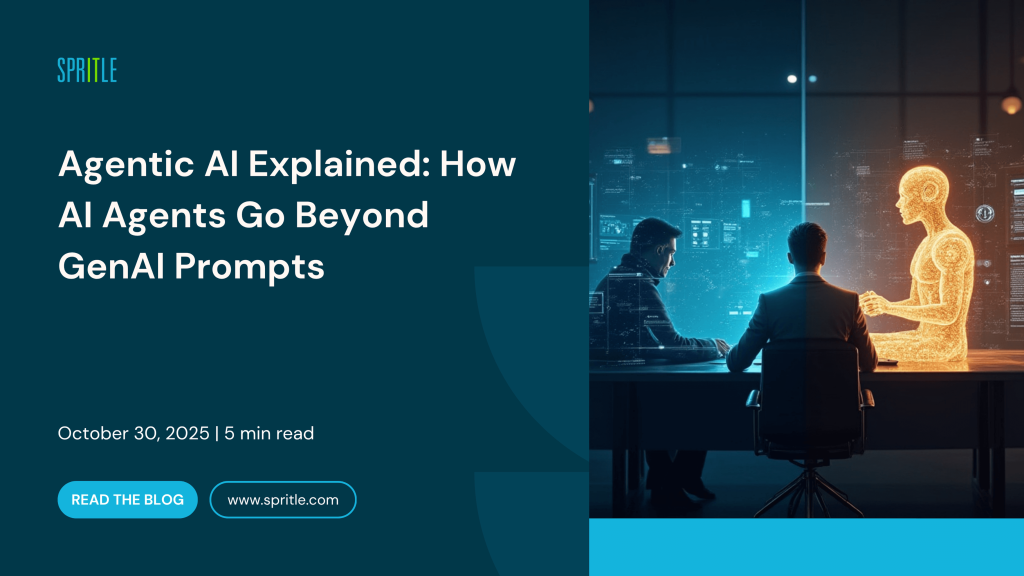
Generative AI (GenAI) has transformed how professionals work—making it possible to draft content, summarize reports, and brainstorm ideas in seconds. These capabilities have been revolutionary, but they also reveal limitations. GenAI often operates in isolated moments, requiring users to re-prompt, copy, paste, and manually integrate outputs into real workflows.
This gap has led to the emergence of Agentic AI a more advanced approach where AI doesn’t just generate, but actively executes tasks, integrates with systems, and carries context across processes. The shift from GenAI to Agentic AI represents a move from tools that provide answers to agents that deliver outcomes.
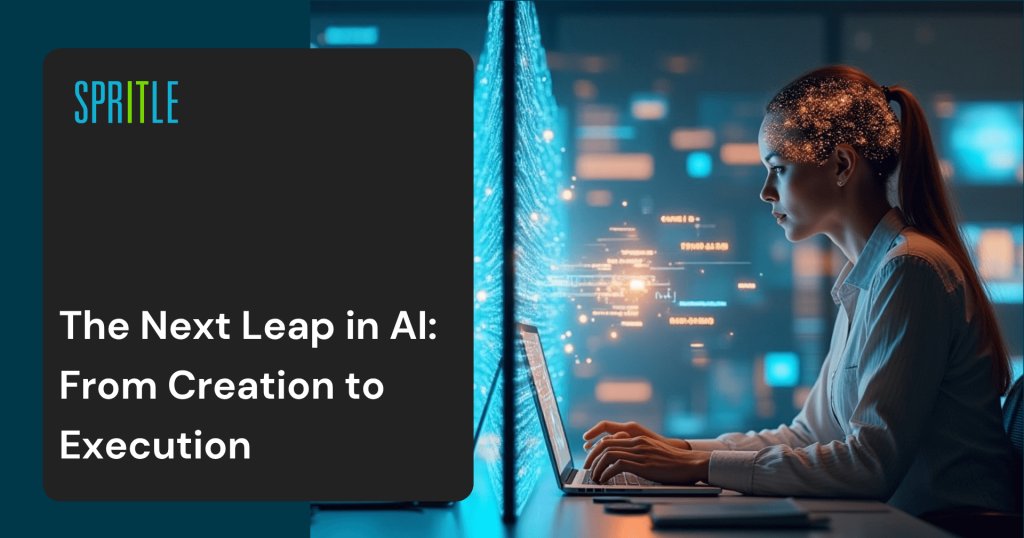
The Limitations of the Prompt Era
When ChatGPT, Claude, and other GenAI tools burst onto the scene, the possibilities felt endless. Suddenly, anyone could:
- Draft marketing copy in seconds
- Summarize dense documents instantly
- Translate content into multiple languages
- Brainstorm creative ideas on demand
It was intoxicating. And for many teams, a huge leap forward.
But as the dust settled, leaders started asking tougher questions:
- Why do we still need humans to orchestrate every step of a workflow?
- Why can’t the AI “remember” what we’ve already done?
- Why does every task start with a new prompt, as if the AI has amnesia?
- Why are outputs often disconnected from real systems where work actually happens?
GenAI’s brilliance was also its blind spot: it could generate, but it couldn’t act.
It gave us answers, but not outcomes.
The Rise of Agentic AI
Agentic AI changes the game by moving beyond single prompts to sustained processes.
Instead of being a clever autocomplete machine, an AI agent becomes an active participant in workflows—planning, executing, and adapting steps toward a goal.
Here’s the difference in practice:
- GenAI: You ask for a draft email → It writes one → You copy it into Outlook → You send it.
- Agentic AI: You assign, “Draft and send a follow-up email to yesterday’s webinar attendees with personalized offers.” The AI:
- Pulls the attendee list from your CRM
- Drafts personalized messages based on attendee profiles
- Schedules the emails in your marketing system
- Flags any anomalies in the data for review
- Sends, tracks, and reports back—all without re-prompting.
- Pulls the attendee list from your CRM
That’s not just a smarter chatbot. That’s a teammate.
What Makes Agentic AI Different?
From our work with fintechs, healthcare providers, and enterprise ops teams, we’ve found that Agentic AI succeeds when built on four pillars:
- Goal-Oriented Intelligence
Instead of reacting to prompts, agents understand outcomes. You tell them the destination, they map the route. - Process Awareness
Agents can plan multi-step tasks, maintain context across interactions, and adapt as conditions change. - System Integration
They connect directly to your tools—CRMs, ERPs, databases, APIs—so outputs don’t just sit in a doc. They’re executed. - Memory & Learning
Unlike prompt-based AI that “forgets” everything after each chat, agents retain context and build institutional knowledge over time.
Add in guardrails for compliance, accuracy, and ethics, and you’ve got an AI that isn’t just creative—it’s dependable.
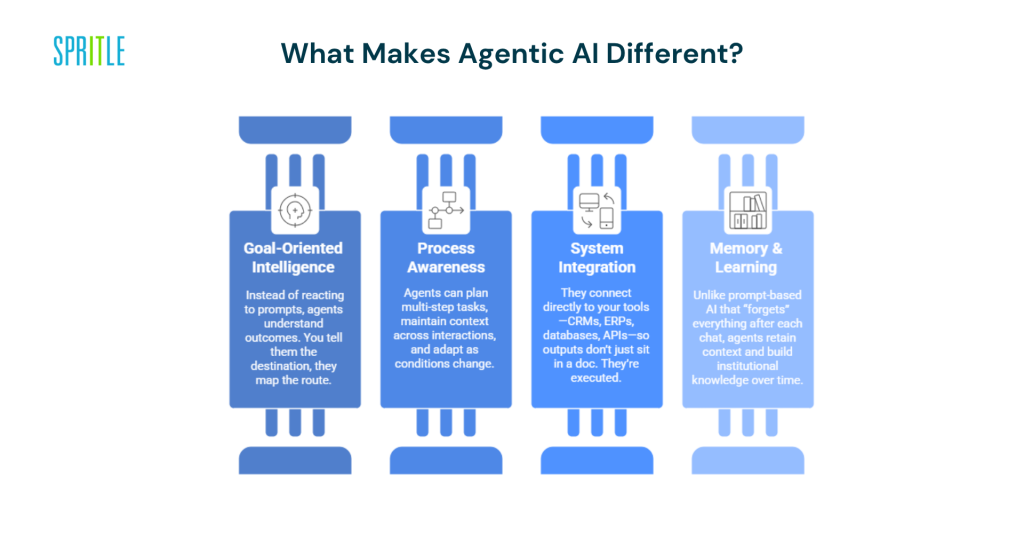
A Real-World Example: From Firefighting to Flow
One operations team we worked with was drowning in repetitive, manual tasks:
- Gathering weekly reports from multiple systems
- Cleaning and reconciling data
- Preparing dashboards for leadership
- Flagging risks and anomalies
- Assigning follow-up tasks in Jira and Slack
They were already using GenAI tools, but those only helped with snippets: summarizing text, rewording updates, drafting emails.
The process—the real bottleneck—was still manual.
The Agentic Approach
We built a multi-agent system designed around their workflows:
- Data Agent: Pulled, cleaned, and validated data from internal systems.
- Analysis Agent: Spotted trends, anomalies, and KPI shifts.
- Reporting Agent: Generated executive-ready summaries with visuals.
- Task Agent: Created Jira tickets for issues and notified stakeholders on Slack.
- Memory Layer: Preserved historical context so comparisons across weeks and quarters were automatic.
Humans stayed in the loop at approval checkpoints, especially where compliance mattered. But the endless swivel-chairing between systems disappeared.
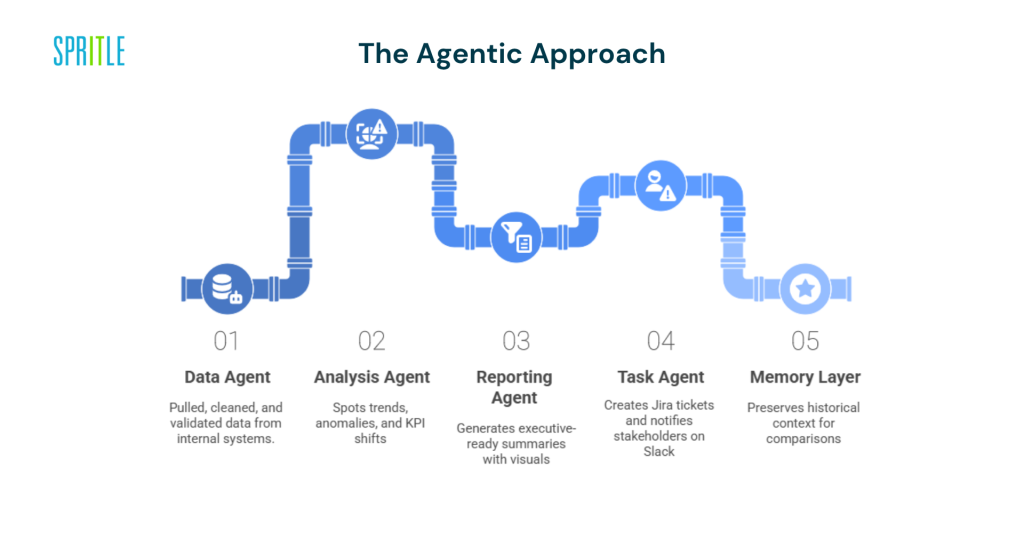
The Results
- Reports generated in hours, not weeks
- Meetings cut by 40%
- Teams freed up to focus on strategy instead of data wrangling
- Leadership receiving more reliable, timely insights
All without hiring a new AI team or building custom ML models from scratch.
Why This Worked
Here’s the truth: AI success isn’t about having the biggest model or the largest headcount.
It’s about smart orchestration.
By focusing on architecture, fine-tuning, and integration—not raw model training—we cut months off the timeline and kept costs lean.
Agentic AI works because it:
- Extends GenAI’s creativity with autonomy
- Bridges human intention with machine execution
- Turns tasks into outcomes
Think of it this way: GenAI gives you a hammer. Agentic AI builds the house.
Lessons for Leaders Considering Agentic AI
If you’re exploring how to bring AI deeper into your organization, here are the questions worth asking:
- Am I still stuck in prompt-land?
If your teams spend their time re-prompting, copy-pasting, and manually stitching together AI outputs, you’re not capturing full value. - Where are my processes leaking time?
Look for workflows with repetitive, structured steps (reporting, triage, onboarding). These are ripe for agents. - Do my agents have context and memory?
A chatbot that forgets your project halfway through isn’t an agent. True Agentic AI carries knowledge forward. - How integrated is my AI?
The magic happens when AI doesn’t just suggest, but acts—creating tickets, updating systems, sending notifications. - What guardrails are in place?
In domains like finance, healthcare, and legal, compliance isn’t optional. Make sure human-in-the-loop checkpoints and audit trails are built in.
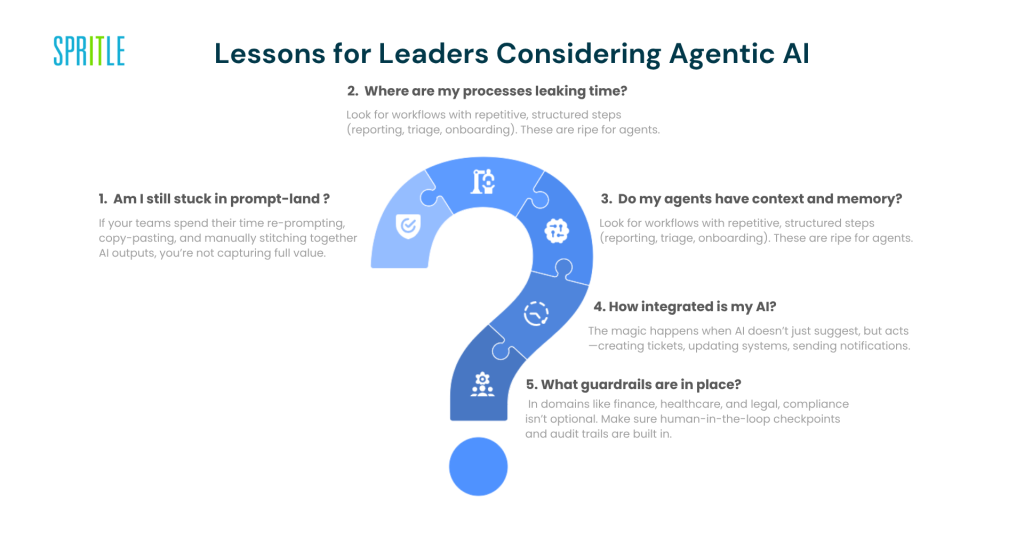
The Bigger Picture: From Tools to Teammates
We’ve seen this movie before.
- The early internet gave us static web pages. Then came interactive apps.
- Early mobile phones made calls. Then smartphones became our assistants.
- Early GenAI wrote snippets. Now Agentic AI is becoming our co-worker.
This shift isn’t about replacing people—it’s about augmenting them.
Imagine:
- A doctor focusing on diagnosis while an AI agent preps all prior patient history.
- A financial analyst focusing on strategy while an AI agent reconciles every transaction in the background.
- A customer success manager spending time with clients while an AI agent auto-generates follow-ups, tracks tickets, and updates dashboards.
The future of work isn’t “humans vs AI.” It’s humans + Agentic AI, each doing what they do best.
Final Thoughts
Generative AI showed us what’s possible. But Agentic AI shows us what’s scalable.
The organizations that thrive won’t be the ones with the flashiest chatbots. They’ll be the ones who master this shift: from one-off prompts to orchestrated processes.
📩 At Spritle Software, we help fintechs, healthcare providers, and enterprises go from idea to AI in production—without the costly, slow, traditional ML hiring route.
If you’re ready to move beyond GenAI, design Agentic AI systems, and build true AI teammates, let’s talk.
